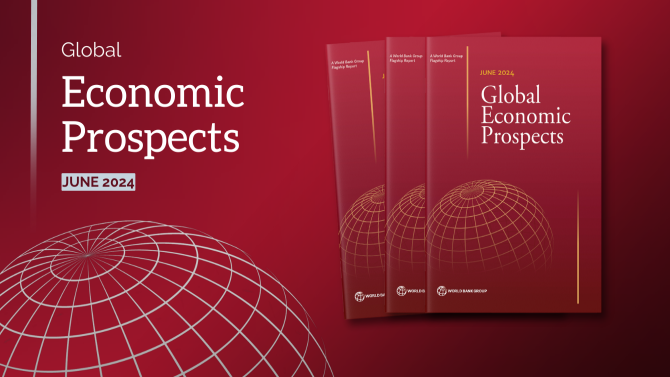But 80% of world population will experience slower growth than in pre-COVID decade

Global growth is projected to hold steady at 2.6% in 2024 before edging up to an average of 2.7% in 2025-26. That is well below the 3.1% average in the decade before COVID-19. The forecast implies that over the course of 2024-26 countries that collectively account for more than 80% of the world’s population and global GDP would still be growing more slowly than they did in the decade before COVID-19.
Overall, developing economies are projected to grow 4% on average over 2024-25, slightly slower than in 2023. Growth in low-income economies is expected to accelerate to 5% in 2024 from 3.8% in 2023. However, the forecasts for 2024 growth reflect downgrades in three out of every four low-income economies since January. In advanced economies, growth is set to remain steady at 1.5% in 2024 before rising to 1.7% in 2025.
“Four years after the upheavals caused by the pandemic, conflicts, inflation, and monetary tightening, it appears that global economic growth is steadying,” said Indermit Gill, the World Bank Group’s Chief Economist and Senior Vice President. “However, growth is at lower levels than before 2020. Prospects for the world’s poorest economies are even more worrisome. They face punishing levels of debt service, constricting trade possibilities, and costly climate events. Developing economies will have to find ways to encourage private investment, reduce public debt, and improve education, health, and basic infrastructure. The poorest among them—especially the 75 countries eligible for concessional assistance from the International Development Association—will not be able to do this without international support.”
This year, one in four developing economies is expected to remain poorer than it was on the eve of the pandemic in 2019. This proportion is twice as high for countries in fragile- and conflict-affected situations. Moreover, the income gap between developing economies and advanced economies is set to widen in nearly half of developing economies over 2020-24 —the highest share since the 1990s. Per capita income in these economies—an important indicator of living standards—is expected to grow by 3.0% on average through 2026, well below the average of 3.8% in the decade before COVID-19.
Global inflation is expected to moderate to 3.5% in 2024 and 2.9% in 2025, but the pace of decline is slower than was projected just six months ago. Many central banks, as a result, are expected to remain cautious in lowering policy interest rates. Global interest rates are likely to remain high by the standards of recent decades—averaging about 4% over 2025-26, roughly double the 2000-19 average.
“Although food and energy prices have moderated across the world, core inflation remains relatively high—and could stay that way,” said Ayhan Kose, the World Bank’s Deputy Chief Economist and Director of the Prospects Group. “That could prompt central banks in major advanced economies to delay interest-rate cuts. An environment of ‘higher-for-longer’ rates would mean tighter global financial conditions and much weaker growth in developing economies.”
The latest Global Economic Prospects report also features two analytical chapters of topical importance. The first outlines how public investment can be used to accelerate private investment and promote economic growth. It finds that public investment growth in developing economies has halved since the global financial crisis, dropping to an annual average of 5% in the past decade. Yet public investment can be a powerful policy lever. For developing economies with ample fiscal space and efficient government spending practices, scaling up public investment by 1% of GDP can increase the level of output by up to 1.6% over the medium term.
The second analytical chapter explores why small states—those with a population of around 1.5 million or less—suffer chronic fiscal difficulties. Two-fifths of the 35 developing economies that are small states are at high risk of debt distress or already in it. That’s roughly twice the share for other developing economies. Comprehensive reforms are needed to address the fiscal challenges of small states. Revenues could be drawn from a more stable and secure tax base. Spending efficiency could be improved —especially in health, education, and infrastructure. Fiscal frameworks could be adopted to manage the higher frequency of natural disasters and other shocks. Targeted and coordinated global policies can also help put these countries on a more sustainable fiscal path.
Download the full report: https://bit.ly/GEP-June-2024-FullReport
Download growth data: https://bit.ly/GEP-June-2024-Data
Download charts: https://bit.ly/GEP-June-2024-Charts
Regional Outlooks:
East Asia and Pacific: Growth is expected to decelerate to 4.8% in 2024 and to 4.2% in 2025. For more, see regional overview.
Europe and Central Asia: Growth is expected to edge down to 3.0% in 2024 before moderating to 2.9% in 2025. For more, see regional overview.
Latin America and the Caribbean: Growth is expected to decline to 1.8% in 2024 before picking up to 2.7% in 2025. For more, see regional overview.
Middle East and North Africa: Growth is expected to pick up to 2.8% in 2024 and 4.2% in 2025. For more, see regional overview.
South Asia: Growth is expected to slow to 6.2% in 2024 and remain steady at 6.2% in 2025. For more, see regional overview.
Sub-Saharan Africa: Growth is expected to pick up to 3.5% in 2024 and to 3.9% in 2025. For more, see regional overview.
Website: www.worldbank.org/gep
Facebook: facebook.com/worldbank
X (Twitter): twitter.com/worldbank
YouTube: youtube.com/worldbank
